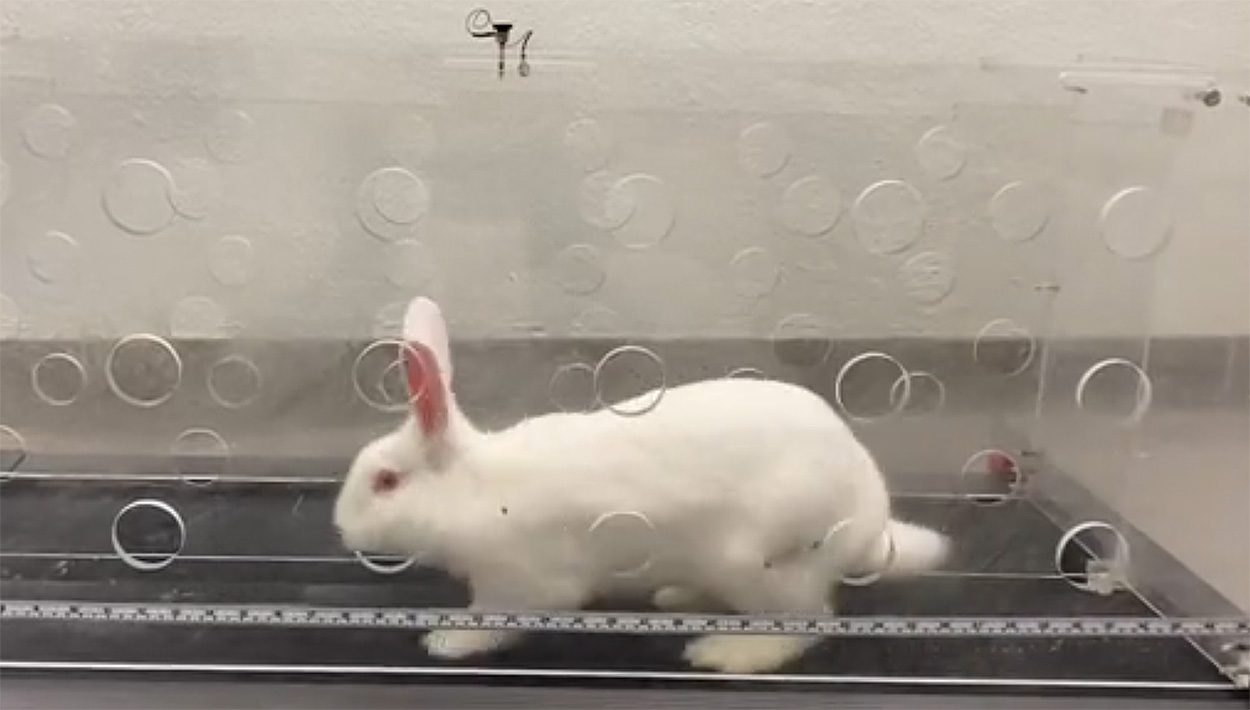Cartilage damage in the knee, for example from injuries or osteoarthritis, cannot yet be healed. Researchers have now tried a new approach to rabbits: They’ve implanted a biodegradable structure made of nanofibers into the affected joint. This is designed in such a way that it generates an electrical potential, which is propelled by the movements of the rabbit. This stimulates the cells to form new cartilage. In animals treated in this way, the damaged cartilage tissue healed almost completely within one to two months of training. Additional studies should clarify to what extent an application in humans might be considered.
Osteoarthritis is the most common joint disease in Germany and one of the main causes of chronic pain. The wear and tear and chronic arthritis leads to the breakdown of cartilage in the joints, which eventually leads to bone-to-bone rubbing. Anti-inflammatory pain relievers can relieve symptoms and slow the breakdown, but not reverse it. Previous therapeutic approaches have attempted to replace damaged cartilage with a healthy piece from another part of the body. But when you do that, the extraction point gets damaged. Attempts to regrow the cartilage in the damaged joint encountered the problem that the regrown cartilage was less stable than normal.
Electro-active nano scaffolding
A team led by Yang Lui of the University of Connecticut has tested a new method that also aims to regrow cartilage. While previous experiments generally worked with chemical growth factors, Lewis’ team relied on electrical signals instead. “Studies have shown that cartilage reacts to electrical stimulation,” the researchers explained. “Electric fields promote tissue regeneration.” So the researchers created a framework made of nanofibers that, when subjected to mechanical stress, generate an electrical potential, known as piezoelectricity. They used poly-L-lactic acid as a material, a biodegradable polymer that is used, among other things, for suturing surgical wounds.
In fact, with newly developed scaffolds, they succeeded in growing cartilage in cell culture. To test its effectiveness in real joints, the researchers first caused severe cartilage damage to several rabbits’ knees, similar to what happened in people with osteoarthritis. They then implanted a piezoelectric nanoscaffold in one group of rabbits, and a similar nanoscaffold without piezoelectric activity in another group. The no-implant group served as a control group.
Almost complete cartilage regeneration
After a four-week recovery period after surgery, the researchers put half of the rabbits from each group into an exercise program. The animals had the opportunity to jump on the treadmill. As a result of the movement, the piezoelectric material was compressed and stretched in rabbits with a corresponding implant, generating a weak electric field. After one to two months, the researchers killed the rabbits and examined the extent of cartilage regeneration.
The result: In animals that underwent a piezoelectric implant and were then trained, the damaged cartilage was regenerated almost completely. There was no difference whether the training lasted for a month or two. “Just one month of training resulted in significant cartilage healing and left little room for further improvement,” the researchers explained. By contrast, cartilage healing was significantly slower in rabbits who did not receive a piezoelectric implant or were not trained.
More studies are needed
“Piezoelectricity is a phenomenon that is also present in the human body. Bones, cartilage, collagen, DNA, and various proteins have a piezoelectric response. Our approach to treating cartilage is highly clinically applicable, and we will investigate the healing mechanisms involved,” says Liu. However, before the results can actually be converted into practice, further studies are required. “With our study, we’ve shown that the concept works in principle,” says Nguyen, Liu’s colleague. “The result is great, but we still have to test it on animals that are larger and closer to humans in terms of size and weight. Additionally, the animals should be monitored for at least one year in future studies to ensure the viability of the cartilage.”
Quelle: Yang Liu (University of Connecticut, USA) et al, Science Translational Medicine, doi: 10.1126/scitranslmed.abi7282

“Alcohol buff. Troublemaker. Introvert. Student. Social media lover. Web ninja. Bacon fan. Reader.”





More Stories
Huge radiation explosion from a magnetar – forschung.de
Principles and features of the folk nutritional principle
Science: The percentage of women in mint topics rises to a third